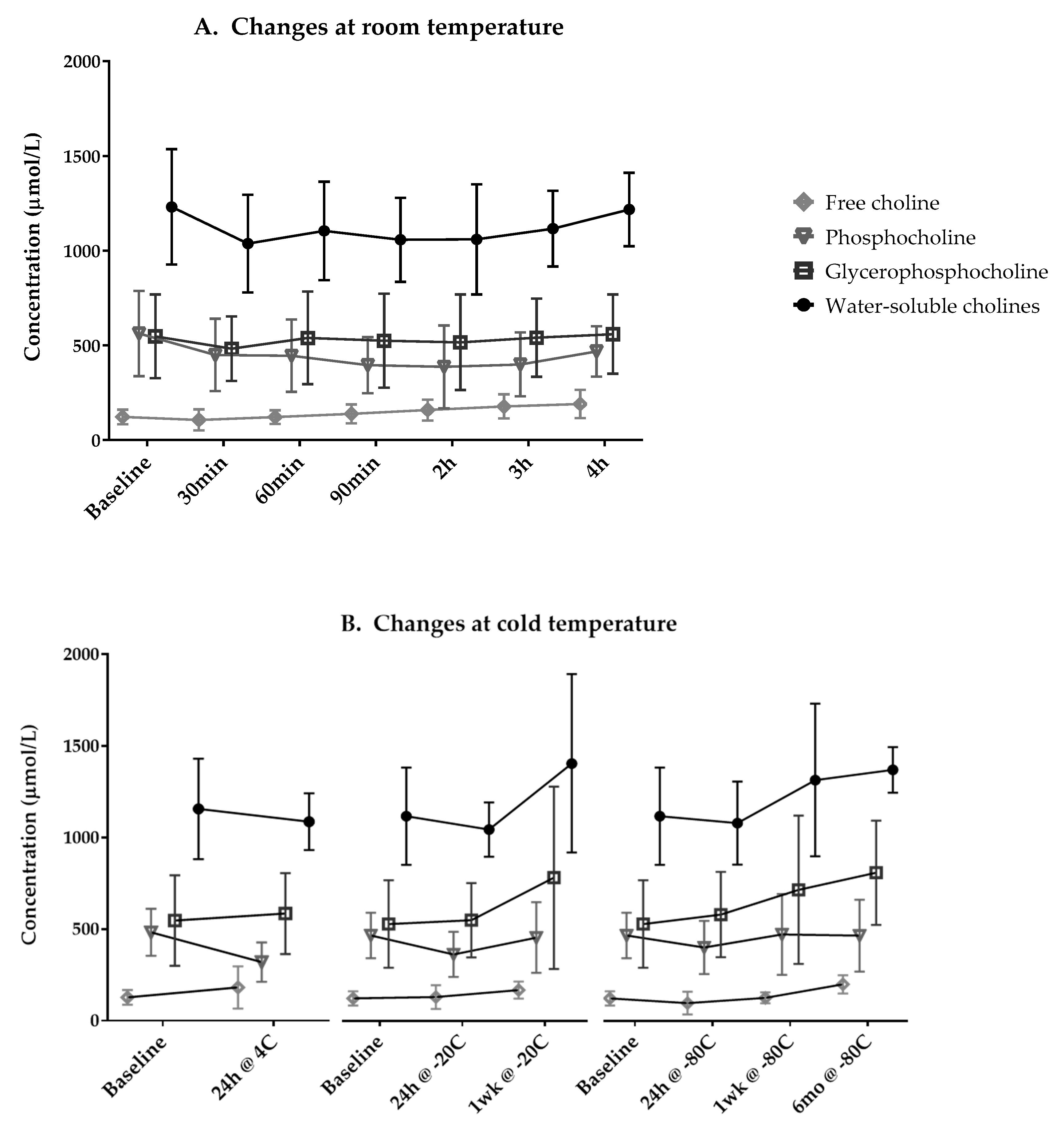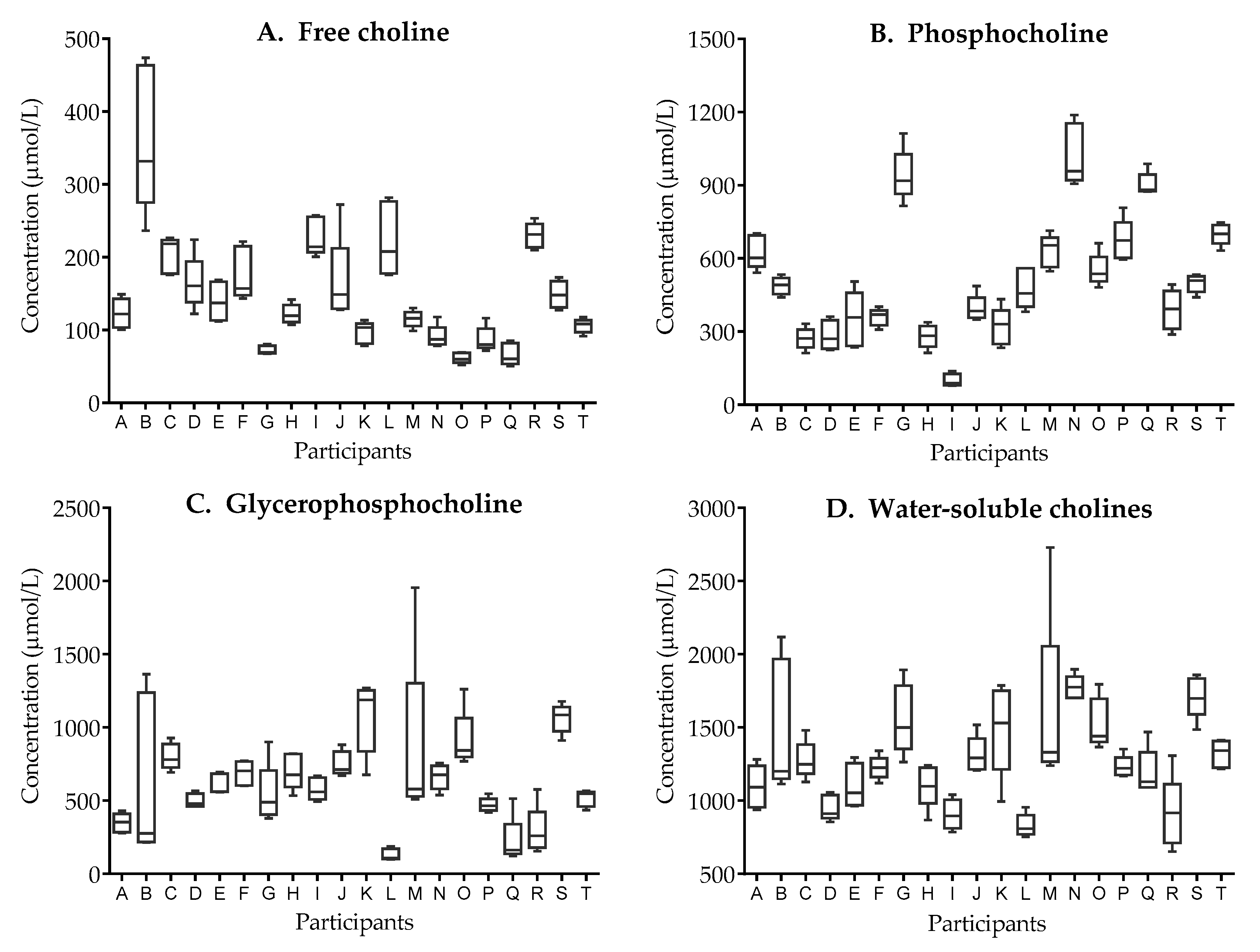Variability of Water-Soluble Forms of Choline Concentrations in Human Milk during Storage, after Pasteurization, and among Women
Abstract
1. Introduction
2. Materials and Methods
2.1. Participants and Study Design
2.1.1. Stability Study
2.1.2. Pasteurization Study
2.1.3. Variability Study
2.2. Human Milk Choline Quantitation
2.3. Statistical Analysis
3. Results
3.1. Participant Characteristics
3.2. Stability of Water-Soluble Choline Forms at Different Storage Conditions
3.3. Stability of Water-Soluble Choline Forms during Pasteurization
3.4. Intra- and Inter-Individual Variability of Water-Soluble Forms of Choline Concentrations
4. Discussion
Supplementary Materials
Author Contributions
Funding
Acknowledgments
Conflicts of Interest
References
- Zeisel, S.; Niculescu, M. Perinatal choline influences brain structure and function. Nutr. Rev. 2006, 64, 197–203. [Google Scholar] [CrossRef] [PubMed]
- Zeisel, S.H. Nutritional Importance of Choline for Brain Development. J. Am. Coll. Nutr. 2004, 23, 621S–626S. [Google Scholar] [CrossRef] [PubMed]
- Zeisel, S.H. Choline: Critical Role During Fetal Development and Dietary Requirements in Adults. Annu. Rev. Nutr. 2006, 26, 229–250. [Google Scholar] [CrossRef]
- Zeisel, S.H.; Blusztajn, J.K. Choline and Human Nutrition. Rev. Nutr 1994, 14, 269–296. [Google Scholar] [CrossRef]
- Zeisel, S.H. Biochemistry, physiology, and pharmacology. Ann. Rev. Nutr. 1981, 1, 121. [Google Scholar] [CrossRef]
- Jiang, X.; West, A.A.; Caudill, M.A. Maternal choline supplementation: A nutritional approach for improving offspring health? Trends Endocrinol. Metab. 2014, 25, 263–273. [Google Scholar] [CrossRef]
- Craig, S.A. Betaine in human nutrition. Am. J. Clin. Nutr. 2004, 80, 539–549. [Google Scholar] [CrossRef]
- WHO Exclusive Breastfeeding for Six Months Best for Babies Everywhere. Available online: http://www.who.int/mediacentre/news/statements/2011/breastfeeding_20110115/en (accessed on 17 July 2019).
- Holmes, H.C.; Snodgrass, G.J.A.I.; Iles, R.A. Changes in the choline content of human breast milk in the first 3 weeks after birth. Eur. J. Pediatr. 2000, 159, 198–204. [Google Scholar] [CrossRef]
- Ilcol, Y.O.; Ozbek, R.; Hamurtekin, E.; Ulus, I.H. Choline status in newborns, infants, children, breast-feeding women, breast-fed infants and human breast milk. J. Nutr. Biochem. 2005, 16, 489–499. [Google Scholar] [CrossRef]
- Fischer, L.M.; Da Costa, K.A.; Galanko, J.; Sha, W.; Stephenson, B.; Vick, J.; Zeisel, S.H. Choline intake and genetic polymorphisms influence choline metabolite concentrations in human breast milk and plasma. Am. J. Clin. Nutr. 2010, 92, 336–346. [Google Scholar] [CrossRef]
- Holmes-McNary, M.Q.; Cheng, W.L.; Mar, M.H.; Fussell, S.; Zeisel, S.H. Choline and choline esters in human and rat milk and in infant formulas. Am. J. Clin. Nutr. 1996, 64, 572–576. [Google Scholar] [CrossRef] [PubMed]
- Davenport, C.; Yan, J.; Taesuwan, S.; Shields, K.; West, A.A.; Jiang, X.; Perry, C.A.; Malysheva, O.V.; Stabler, S.P.; Allen, R.H.; et al. Choline intakes exceeding recommendations during human lactation improve breast milk choline content by increasing PEMT pathway metabolites. J. Nutr. Biochem. 2015, 26, 903–911. [Google Scholar] [CrossRef] [PubMed]
- Jaeger, M.C.; Lawson, M.; Filteau, S. The impact of prematurity and neonatal illness on the decision to breast-feed. J. Adv. Nurs. 1997, 25, 729–737. [Google Scholar] [CrossRef] [PubMed]
- Johns, H.M.; Forster, D.A.; Amir, L.H.; McLachlan, H.L. Prevalence and outcomes of breast milk expressing in women with healthy term infants: A systematic review. BMC Pregnancy Childbirth 2013, 13, 212. [Google Scholar] [CrossRef]
- Jones, F. Best Practice for Expressing, Storing and Handling Human Milk in Hospitals, Homes, and Child Care Settings, 3rd ed.; Human Milk Banking Association of North America, Inc.: Fort Worth, TX, USA, 2011. [Google Scholar]
- Eglash, A.; Simon, L.; Brodribb, W.; Reece-Stremtan, S.; Noble, L.; Brent, N.; Bunik, M.; Harrel, C.; Lawrence, R.A.; LeFort, Y.; et al. ABM Clinical Protocol #8: Human Milk Storage Information for Home Use for Full-Term Infants, Revised 2017. Breastfeed. Med. 2017, 12, 390–395. [Google Scholar]
- Donnelly-Vanderloo, M.; O’Connor, D.L.; Shoukri, M. Impact of pasteurization and procedures commonly used to rethermalize stored human milk on folate content. Nutr. Res. 1994, 14, 1305–1316. [Google Scholar] [CrossRef]
- Peila, C.; Moro, G.; Bertino, E.; Cavallarin, L.; Giribaldi, M.; Giuliani, F.; Cresi, F.; Coscia, A. The Effect of Holder Pasteurization on Nutrients and Biologically-Active Components in Donor Human Milk: A Review. Nutrients 2016, 8, 477. [Google Scholar] [CrossRef]
- García-Lara, N.R.; Escuder-Vieco, D.; García-Algar, O.; De la Cruz, J.; Lora, D.; Pallás-Alonso, C. Effect of Freezing Time on Macronutrients and Energy Content of Breastmilk. Breastfeed. Med. 2012, 7, 295–301. [Google Scholar] [CrossRef]
- Ahrabi, A.F.; Handa, D.; Codipilly, C.N.; Shah, S.; Williams, J.E.; McGuire, M.A.; Potak, D.; Aharon, G.G.; Schanler, R.J. Effects of Extended Freezer Storage on the Integrity of Human Milk. J. Pediatr. 2016, 177, 140–143. [Google Scholar] [CrossRef]
- Zeisel, S.H.; Char, D.; Sheard, N.F. Choline, phosphatidylcholine and sphingomyelin in human and bovine milk and infant formulas. J. Nutr. 1986, 116, 50–58. [Google Scholar] [CrossRef]
- Innis, S.M.; Friesen, R.W. Essential n-3 fatty acids in pregnant women and early visual acuity maturation in term infants. Am. J. Clin. Nutr. 2008, 87, 548–557. [Google Scholar] [CrossRef]
- Moukarzel, S.; Soberanes, L.; Dyer, R.A.; Albersheim, S.; Elango, R.; Innis, S.M.; Moukarzel, S.; Soberanes, L.; Dyer, R.A.; Albersheim, S.; et al. Relationships among Different Water-Soluble Choline Compounds Differ between Human Preterm and Donor Milk. Nutrients 2017, 9, 369. [Google Scholar] [CrossRef]
- Peters, M.D.J.; McArthur, A.; Munn, Z. Safe management of expressed breast milk: A systematic review. Women Birth 2016, 29, 473–481. [Google Scholar] [CrossRef]
- Nessel, I.; Khashu, M.; Dyall, S.C. The effects of storage conditions on long-chain polyunsaturated fatty acids, lipid mediators, and antioxidants in donor human milk—A review. Prostaglandins Leukot. Essent. Fat. Acids 2019, 149, 8–17. [Google Scholar] [CrossRef]
- Loikas, S.; Lopponen, M.; Suominen, P.; Moller, J.; Irjala, K.; Isoaho, R.; Kivela, S.L.; Koskinen, P.; Pelliniemi, T.T. RIA for serum holo-transcobalamin: Method evaluation in the clinical laboratory and reference interval. Clin. Chem. 2003, 49, 455–462. [Google Scholar] [CrossRef]
- O’Connor, D.L.; Ewaschuk, J.B.; Unger, S. Human milk pasteurization: Benefits and risks. Curr. Opin. Clin. Nutr. Metab. Care 2015, 18, 269–275. [Google Scholar] [CrossRef]
- Gao, C.; Miller, J.; Middleton, P.F.; Huang, Y.C.; McPhee, A.J.; Gibson, R.A. Changes to breast milk fatty acid composition during storage, handling and processing: A systematic review. Prostaglandins Leukot. Essent. Fat. Acids 2019, 146, 1–10. [Google Scholar] [CrossRef]
- Moukarzel, S.; Dyer, R.A.; Keller, B.O.; Elango, R.; Innis, S.M. Human milk plasmalogens are highly enriched in long-chain PUFAs. J. Nutr. 2016, 146, 2412–2417. [Google Scholar] [CrossRef]
- Holm, P.I.; Ueland, P.M.; Kvalheim, G.; Lien, E.A. Determination of choline, betaine, and dimethylglycine in plasma by a high-throughput method based on normal-phase chromatography-tandem mass spectrometry. Clin. Chem. 2003, 49, 286–294. [Google Scholar] [CrossRef]
- Wiedeman, A.M.; Whitfield, K.C.; March, K.M.; Chen, N.N.; Kroeun, H.; Sokhoing, L.; Sophonneary, P.; Dyer, R.A.; Xu, Z.; Kitts, D.D.; et al. Concentrations of Water-Soluble Forms of Choline in Human Milk from Lactating Women in Canada and Cambodia. Nutrients 2018, 10, 381. [Google Scholar] [CrossRef]


| Characteristics Total Sample Size | Stability Study (n = 6) | Pasteurization Study (n = 33) | Variability Study (n = 20) |
|---|---|---|---|
| Age, y | 35 ± 2 1 | 34 ± 4 | 32 ± 4 |
| Postpartum, mo | 4.0 (3.0) 2 | 1 | 4.5 (3.0) |
| First-time breastfeeding, n (%) | 6 (100) | 20 (61) | 10 (50) |
| Ethnic background, n (%) | |||
| European | 2 (33) | 26 (79) | 11 (55) |
| Latin American | 2 (33) | 2 (6) | 4 (20) |
| Middle Eastern | 0 | 3 (9) | 3 (15) |
| First Nation | 1 (17) | 0 | 1 (5) |
| Chinese Asian | 1 (17) | 2 (6) | 1 (5) |
| Choline Form | Before, μmol/L | After, μmol/L | Difference, μmol/L | Difference, % | p-Value 2 |
|---|---|---|---|---|---|
| Free choline | |||||
| Mean ± SD | 124 ± 60 | 124 ± 58 | 0.6 ± 14 | 1.3 ± 10 | 0.893 |
| Median (min; max) | 117 (47.9; 293) | 120 (44.6; 275) | −1 (−29; 46) | −0.5 (−18; 33.0) | |
| Phosphocholine | |||||
| Mean ± SD | 675 ± 220 | 632 ± 189 | −43 ± 73 | −4.7 ± 10 | 0.003 |
| Median (min; max) | 676 (230; 1131) | 621 (261; 960) | −41 (−238; 111) | −6.5 (−21; 25) | |
| Glycerophosphocholine | |||||
| Mean ± SD | 442 ± 181 | 425 ± 181 | −17 ± 43 | −3.6 ± 10 | 0.015 |
| Median (min; max) | 381 (243; 904) | 387 (211; 994) | -20 (-122; 97) | -5.6 (-21; 26) | |
| Total water-soluble choline | |||||
| Mean ± SD | 1241 ± 249 | 1186 ± 201 | −56 ± 124 | −3.4 ± 10 | 0.017 |
| Median (min; max) | 1229 (789; 1794) | 1136 (792; 1566) | −63 (358; 231) | −4.8 (−20; 27) |
| Choline Form | T1 | T2 | T3 | T4 | T5 | p2 |
|---|---|---|---|---|---|---|
| Free choline | ||||||
| Median (IQR) | 119 (73.5) | 125 (63.7) | 131 (75.4) | 146 (119) | 132 (81.1) | 0.029 |
| Range | 51.9–156 | 60.4–253 | 69.2–474 | 59.9–453 | 505–332 | |
| Phosphocholine | ||||||
| Median (IQR) | 490 (328) | 488 (270) | 441 (359) | 457 (330) | 482 (335) | 0.545 |
| Range | 138–906 | 82.1–1113 | 115–1120 | 78.9–1188 | 88.9–958 | |
| Glycerophosphocholine | ||||||
| Median (IQR) | 625 (194) | 559 (280) | 549 (320) | 533 (275) | 682 (408) | 0.008 |
| Range | 187–1363 | 107–1115 | 104–1188 | 99.1–1268 | 155–1445 | |
| Total water-soluble choline | ||||||
| Median (IQR) | 1727 (366) | 1219 (410) | 1200 (308) | 1289 (404) | 1230 (344) | 0.224 |
| Range | 955–2117 | 768–1817 | 809–1894 | 752–1896 | 652–2729 |
© 2019 by the authors. Licensee MDPI, Basel, Switzerland. This article is an open access article distributed under the terms and conditions of the Creative Commons Attribution (CC BY) license (http://creativecommons.org/licenses/by/4.0/).
Share and Cite
Moukarzel, S.; Wiedeman, A.M.; Soberanes, L.S.; Dyer, R.A.; Innis, S.M.; Lamers, Y. Variability of Water-Soluble Forms of Choline Concentrations in Human Milk during Storage, after Pasteurization, and among Women. Nutrients 2019, 11, 3024. https://doi.org/10.3390/nu11123024
Moukarzel S, Wiedeman AM, Soberanes LS, Dyer RA, Innis SM, Lamers Y. Variability of Water-Soluble Forms of Choline Concentrations in Human Milk during Storage, after Pasteurization, and among Women. Nutrients. 2019; 11(12):3024. https://doi.org/10.3390/nu11123024
Chicago/Turabian StyleMoukarzel, Sara, Alejandra M. Wiedeman, Lynda S. Soberanes, Roger A. Dyer, Sheila M. Innis, and Yvonne Lamers. 2019. "Variability of Water-Soluble Forms of Choline Concentrations in Human Milk during Storage, after Pasteurization, and among Women" Nutrients 11, no. 12: 3024. https://doi.org/10.3390/nu11123024
APA StyleMoukarzel, S., Wiedeman, A. M., Soberanes, L. S., Dyer, R. A., Innis, S. M., & Lamers, Y. (2019). Variability of Water-Soluble Forms of Choline Concentrations in Human Milk during Storage, after Pasteurization, and among Women. Nutrients, 11(12), 3024. https://doi.org/10.3390/nu11123024





